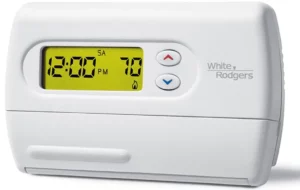
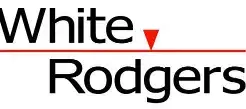
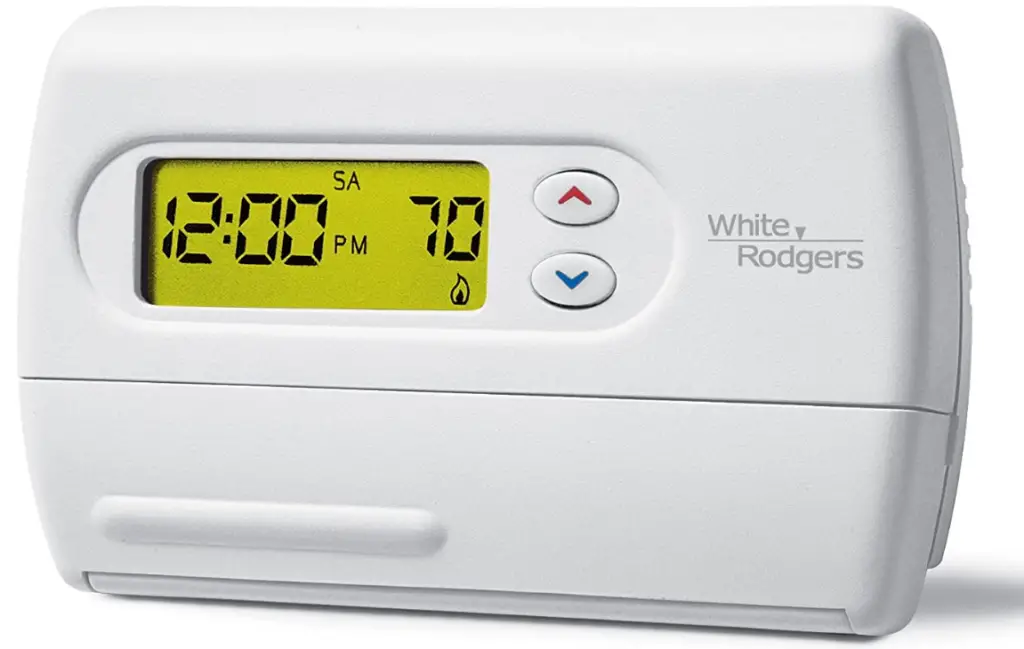
- Product Dimensions
0.81 x 6 x 4.63 inches - Item Weight
0.25 Pounds - Power Source
Battery Powered - Controller Type
Hand Control - Voltage
24 Volts - Material
Attribute not applicable for the product - Backlight
Yes - Shape
Curved - Batteries
2 AA batteries - Electrical Rating
8 to 30 VAC 50/60 Hz. or D.C.
0.05 to 1.0 Amps (Load per terminal)
1.5 Amps Maximum Total Load (All 1.5 Amps Maximum Total Load terminals combined) - THERMAL DATA
Setpoint Temperature Range: Setpoint Temperature Range:
45°F to 90°F (7°C to 32°C) - Operating Ambient Temperature Range: Operating Ambient Temperature Range:
32°F to 105°F - Operating Humidity Range: Operating Humidity Range:
0 to 90% RH (non-condensing) - Shipping Temperature Range: Shipping Temperature Range:
-4°F to 149°F
- Brand
White-Rodgers
Introduction
Single Stage, Emerson Classic 80 Series (1H/1C) 5+1+1 Programmable Day Backlit digital thermostat with 24 volts or millivolts, Switching between Heat, Off, and Cool Range 45–90° F, Fan Switch-Auto, On, Horizontal Profile, Dual Power (System and or Battery). Terminals-RC,C,RH,W,Y,G,O,B. swaps out 1F80-261.
What’s In the Box?
- White-Rodgers 1F80-361 YELLOW DISPLAY Thermostat Wall 1-Stage 1Ht/1C
- User Manual
Your new White-Rodgers 5-Day/1-Day/1-Day Digital Thermostat uses the technology of a solid-state microcomputer to provide precise time/temperature control. This thermostat offers you the flexibility to design heating and cooling programs that fit your needs.
Features
- Separate 5-day (weekday), 1-day (Sat) and 1-day (Sun) programming with four separate time/temperature periods per day
- Simultaneous heat and cool program storage
- Preprogrammed temperature control
- Backlit display
- LCD continuously displays setpoint, and alternately displays time and room temperature
- Temperature override until next program period
- Manual program override (HOLD temperature)
- Temporary HOLD
- °F/°C convertibility
- Temperature range 45° to 90°F
- RC, RH, C, W, Y, G , O and B terminals
- Optional C terminal (Dual Power option)
- B and O terminals for single stage heat pumps (no auxiliary heat) or damper operation
- Program storage in case of power loss
- 2 “AA” alkaline batteries included
PRECAUTIONS
This thermostat is intended for use with a low voltage system; do not use this thermostat with a line voltage system. If in doubt about whether your wiring is millivolt, line, or low voltage, have it inspected by a qualified heating and air conditioning contractor or electrician.
Do not exceed the specification ratings
All wiring must conform to local and national electrical codes and ordinances. This control is a precision instrument, and should be handled carefully. Rough handling or distorting components could cause the control to malfunction.
CAUTION
To prevent electrical shock and/or equipment damage, To prevent electrical shock and/or equipment damage, disconnect electric power to system at main fuse or circuit breaker box until installation is complete. circuit breaker box until installation is complete.
WARNING
Do not use on circuits exceeding specified voltage. Do not use on circuits exceeding specified voltage. Higher voltage will damage control and could cause shock or fire hazard. shock or fire hazard. Do not short out terminals on gas valve or primary control Do not short out terminals on gas valve or primary control to test. Short or incorrect wiring will damage thermostat to test. Short or incorrect wiring will damage thermostat and could cause personal injury and/or property damage. Thermostat installation and all components of the system shall conform to Class II circuits per the NEC code. tem shall conform to Class II circuits per the NEC code.
INSTALLATION
REMOVE OLD THERMOSTAT
- Shut off electricity at the main fuse box until installation is complete. Ensure that electrical power is disconnected.
- Remove the front cover of the old thermostat. With wires still attached, still attached, remove wall plate from the wall. If the old thermostat has a wall mounting plate, remove the thermostat and the wall mounting plate as an assembly.
- Identify each wire attached to the old thermostat using the labels enclosed with the new thermostat. the labels enclosed with the new thermostat.
- Disconnect the wires from old thermostat one at a time. DO NOT LET WIRES FALL BACK INTO THE WALL. NOT LET WIRES FALL BACK INTO THE WALL.
- Install new thermostat using the following procedures
ATTENTION
This product does not contain mercury. However, this product may replace a unit which contains mercury. Do not open mercury cells. If a cell becomes damaged, do not touch any spilled mercury. Wearing nonabsorbent gloves, take up the spilled mercury with sand or other absorbent material and place into a container which can be sealed. If a cell becomes damaged, the unit should be discarded. Mercury must not be discarded in household trash. When the unit this product is replacing is to be discarded, place in a suitable container and return to White-Rodgers at 2895 Harrison Street, Batesville, AR 72501 for proper disposal.
ELECTRIC HEAT OR SINGLE-STAGE HEAT PUMP SYSTEMS
This thermostat is configured from the factory to operate a heat/ cool, fossil fuel (gas, oil, etc.), forced air system. It is configured correctly for any system that DOES NOT require the thermostat to energize the fan on a call for heat. If your system is an electric heat or heat-pump system that REQUIRES the thermostat to turn on the fan on a call for heat, locate the ELECTRIC/GAS switch on switch the back of the thermostat (see fig. 1) and switch it to the ELECTRIC ELECTRIC position. This will allow the thermostat to energize the fan immediately on a call for heat. If you are unsure if the heating/cooling system requires the thermostat to control the fan, contact a qualified heating and air conditioning service person.
ATTACH THERMOSTAT BASE TO WALL
- Remove the packing material from the thermostat. Gently pull the cover straight off the base. Forcing or prying on the thermostat will cause damage to the unit. If necessary, move
the electric heat switch (see ELECTRIC HEAT SYSTEMS, ELECTRIC HEAT SYSTEMS above). - Connect wires beneath terminal screws on base usingzappropriate wiring schematic (see figs. 2 through 7).
- Place base over hole in wall and mark mounting hole locations on wall using base as a template.
- Move base out of the way. Drill mounting holes.
- Fasten base loosely to wall, as shown in fig. 1, using two mounting screws. Place a level against bottom of base, adjust until level, and then tighten screws. (Leveling is for appearance only and will not affect thermostat operation.) If you are using existing mounting holes, or if holes drilled are too large and do not allow you to tighten base snugly, use plastic screw anchors to secure subbase.
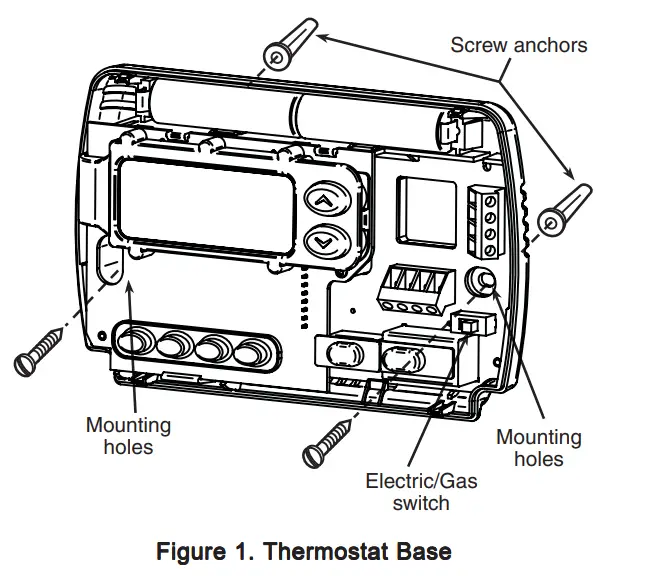
- Push excess wire into wall and plug hole with a fire-resistant material (such as fiberglass insulation) to prevent drafts from affecting thermostat operation.
BATTERY LOCATION
2 “AA” alkaline batteries are included in the thermostat at the factory with a battery tag to prevent power drainage. You must You must remove the battery tag to engage the batteries. remove the battery tag to engage the batteries
If “BATT” is “BATT” displayed, the batteries are low and should be replaced. For best results, replace all batteries with new premium brand alkaline batteries such as Duracell® or Energizer®. To replace batteries, install the batteries along the top of the base (see Fig. 1). The batteries must be installed with the positive (+) end to the left.
HYDRONIC (HOT WATER OR STEAM) HEATING SYSTEMS
This thermostat is set to operate properly with a forced-air heating system. If you have a hydronic heating system (a system that heats with hot water or steam), you must set the thermostat to operate properly with your system. Change the second option in the configuration menu to SL (see CONFIGURATION MENU, page 4).
CHECK THERMOSTAT OPERATION
If at any time during testing your system does not operate properly, contact a qualified service person. Turn on power to the system.
Fan Operation
If your system does not does not have a does not G terminal connection, skip to G Heating System.
- Move FAN switch to ON position. The blower should begin to operate.
- Move FAN switch to AUTO position. The blower should stop immediately
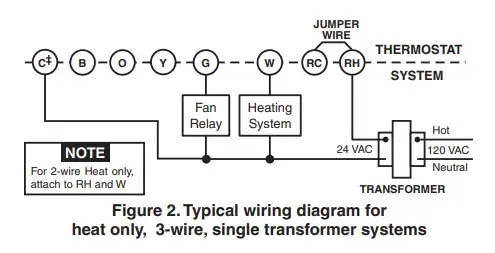
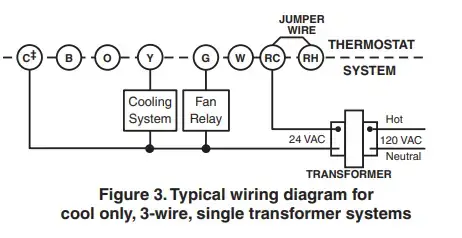
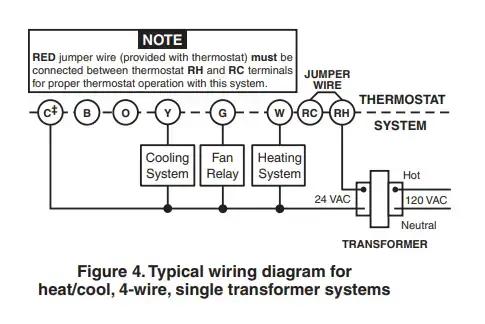

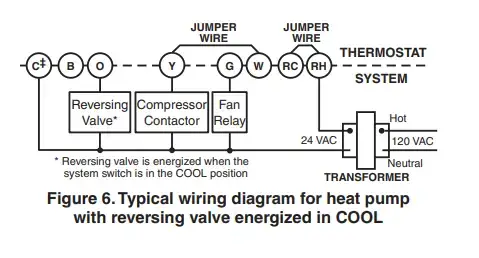
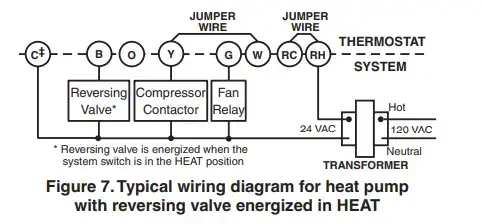
The 24 Volt neutral connection to terminal C on the thermostat is not required if the batteries are replaced once a year with fresh premium brand alkaline batteries.
Heating System
- Move SYSTEM switch to HEATposition. If the heating system has a standing pilot, be sure to light it
- Press
 to adjust the thermostat setting above room temperature. The heating system should begin to operate.
to adjust the thermostat setting above room temperature. The heating system should begin to operate. - Press
 to adjust the temperature setting below room temperature. The heating system should stop operating.
to adjust the temperature setting below room temperature. The heating system should stop operating.
Cooling System
CAUTION
To prevent compressor and/or property damage, if the outdoor temperature is below 50°F, DO NOT operate the cooling system. the cooling system.
- Move SYSTEM switch to COOLposition.
- . Press
 to adjust the thermostat setting below room temperature. The blower should come on immediately on high speed, followed by cold air circulation.
to adjust the thermostat setting below room temperature. The blower should come on immediately on high speed, followed by cold air circulation. - Press
 to adjust the temperature setting above room temperature. The cooling system should stop operating.
to adjust the temperature setting above room temperature. The cooling system should stop operating.
OPERATION
Before you begin programming your thermostat, you should be familiar with its features and with the display, and the location and operation of the thermostat buttons. Your thermostat consists of two parts: the thermostat cover and the base. To base remove the cover, and pull it straight out from the base. To replace the cover, line up the cover with the base and press until the cover snaps onto the base.
The Thermostat Buttons The Thermostat Buttons and Switches
- Raises temperature setting.
- Lowers temperature setting.
- TIME button.
- PRGM (program) button.
- RUN (run program) button.
- HOLD temperature button.
- FAN switch (ON, AUTO).
- SYSTEM switch (COOL, OFF, HEAT)
The Display - Indicates the day of the week.
- The flame icon ( Flame icon ) is displayed when the SYSTEM switch is in the HEAT position. The snowflake icon ( Snowflake icon )is displayed (nonflashing) when the SYSTEM switch is in the COOL position. Snowflake is Snowflake displayed (flashing) if the thermostat is in lockout mode to prevent the compressor from cycling too quickly.
- Displays “BATT” when the 2 “AA” batteries are low and should be replaced. Only “BATT” and “LO” in “LO” the minutes field is displayed when batteries are low with no system
power. - Alternately displays current time and temperature. Displays “LO” in “LO” the minute’s field when batteries are low.
- The word “HOLD” is “HOLD” displayed when the thermostat is in HOLD mode. “HOLD” is “HOLD” displayed flashing when the thermostat is in a temporary HOLD Mode.
- Displays currently programmed set temperature (this is blank when the SYSTEM switch is in the OFF position). OFF
- Displays “FLTR” when the system has run for the programmed filter time period as a reminder to change or clean your air filter.
CONFIGURATION MENU
The configuration menu allows you to set certain thermostat operating characteristics to your system or personal requirements. Press RUN to make sure the thermostat is in the run program mode, then press PRGM and RUN at the same time to enter the configuration menu. The display will show the first item in the configuration menu. The configuration menu table summarizes the configuration options. An explanation of each option follows.

Press HOLD to change to the next menu item or press TIME to go back to the previous item in the menu. To exit the menu and return to the program operation, press RUN. If no keys are pressed within fifteen minutes, the thermostat will revert to normal operation.
- Select Temporary Hold Time Select Temporary Hold Time
Select Temporary Hold Time The thermostat can hold any temperature you set it to for the amount of time you select on this option. Your choices are 0:00 to 8:00 hours in 15-minute increments. 0:00 disables the function.
Example- You have selected 3:00 hours for the Temporary Hold time period.
- With the thermostat set to Heat or Cool, press HOLD for approximately five seconds until HOLD time (3:00 indicating 3 hours) appears as a set reminder.
- After releasing the button, “HOLD” on the display will “HOLD” blink.
- Use or set the temperature to your preference. The thermostat will maintain this temperature setting for 3 hours with “HOLD” bli “HOLD” linking to remind you it is in Temporary Hold. After 3 hours the thermostat will go back to the programmed temperature and “HOLD” will no longer blink or display.
- Select FA or SL (Fast or Slow) Heating Cycle Rate
The Select FA or SL (Fast or Slow) Heating Cycle Rate FA setting is frequently used for gas, oil, or electric heat. The SL setting produces a longer heating cycle which is normally for hot water or steam (hydronic) systems. Both settings produce very accurate temperature control and can be set to your personal preference. FA cycles the system just under 1°F and the SL setting cycles at approximately 1.5°F. - Select backlit display
Select backlit display The display backlight improves display contrast in low lighting conditions. Selecting the backlight ON will keep the light on for a short period of time after ON any key is pressed. Selecting OFF will keep the light off.

- Select Energy Management Recovery OFF or ON
Select Energy Management Recovery OFF or ON Energy Management Recovery (EMR) causes the thermostat to start heating or cooling early to make the building temperature reach the program setpoint at the time you specify. Heating will start 5 minutes early for every 1° of temperature required to reach setpoint.
Example
You select EMR and have your heating programmed to 65° at night and 70° at 7 AM. If the building temperature is 65° the difference between 65° and 70° is 5°. Allowing 5 minutes per degree the thermostat setpoint will change to 70° at 6:35 AM. Cooling allows more time per degree because it takes longer to reach temperature. - Select filter replacement run time
Select filter replacement run time The thermostat will display “FLTR” after a set time of operation. This is a reminder to change or clean your air filter. This time can be set from 0 to 1950 hours in 50-hour increments. A selection of 000 will cancel this feature. of 000 will cancel this feature. of 000 will cancel this feature. When “FLTR” is “FLTR” displayed, you can clear it by pressing HOLD and RUN at the same time. This resets the timer and starts counting the hours until the next filter change. Changing the time in the menu also resets the timer. - Select Compressor Lockout LOC OFF or ON
Select Compressor Lockout LOC OFF or ON Selecting LOC ON will cause the thermostat to wait 5 minutes before turning on the compressor if the heating and the cooling system lose power. It will also wait 5 minutes minimum between cooling cycles. This is intended to help protect the compressor from short cycling. Some newer compressors already have a time delay built in and do not require this feature. Your compressor manufacturer can tell you if the feature is already present in their system. When the compressor time delay occurs it will flash the (snowflake icon) for about five minutes then turn on the compressor. - Select Temperature Display Adjustment 4 LO to 4 HI Select Temperature Display Adjustment 4 LO to 4 HI
Select Temperature Display Adjustment 4 LO to 4 HI Allows you to adjust the room temperature display to 4° higher or lower. Your thermostat was accurately calibrated at the factory but you have the option to change the display temperature to match your previous thermostat. - Select F° or C° Readout Select F° or C° Readout
Select F° or C° Readout Changes the display readout to Centigrade or Fahrenheit as required.
OPERATING FEATURES
Now that you are familiar with the thermostat buttons and display, read the following information to learn about the many features of the thermostat.
SIMULTANEOUS HEATING/COOLING PROGRAM STORAGE STORAGE
When programming, you can enter both your heating and cooling programs at the same time. There is no need to reprogram the thermostat at the beginning of each season.
TEMPERATURE OVERRIDE
Press  or
or  until the display shows the temperature you want. The thermostat will override current programming and keep the room temperature at the selected temperature until the next program period begins. Then the thermostat will automatically revert to the program.
until the display shows the temperature you want. The thermostat will override current programming and keep the room temperature at the selected temperature until the next program period begins. Then the thermostat will automatically revert to the program.
HOLD TEMPERATURE
The thermostat can hold any temperature within its range for an indefinite period without reverting to the programmed temperature. Momentarily press the HOLD button. “HOLD” w “HOLD” ill be displayed. Then choose the desired temperature by pressing  or
or  . The thermostat will hold the room temperature at the selected setting until you press the RUN button to start the program operation again.
. The thermostat will hold the room temperature at the selected setting until you press the RUN button to start the program operation again.
CONFIGURATION MENU
Lows you to customize certain thermostat options.
PROGRAMMING YOUR THERMOSTAT
This section will help you plan your thermostat’s program to meet your needs. For maximum comfort and efficiency, keep the following guidelines in mind when planning your program.
- When heating (cooling) your building, program the temperatures to be cooler (warmer) when the building is vacant or during periods of low activity.
- During early morning hours, the need for cooling is usually minimal.
Planning Your Program
Look at the factory preprogrammed times and temperatures are shown in the sample schedule. If this program will suit your needs, simply press the RUN button to begin running the factory preset program.
If you want to change the preprogrammed times and temperatures, follow these steps.
Determine the time periods and temperatures for your weekday and weekend programs. You must program four periods for both the weekday and weekend programs. However, you may use the same heating and cooling temperatures for consecutive time periods. You can choose start times, heating temperatures, and cooling temperatures independently for both weekday and weekend programs (for example, you may select 5:00 AM and 70° as the weekday 1st-period heating start time and temperature, and also choose 7:00 AM and 76° as the weekday 1st-period cooling start time and temperature). Determine the time periods and temperatures for your weekday and weekend programs. You must program four periods for both the weekday and weekend programs. However, you may use the same heating and cooling temperatures for consecutive time periods. You can choose start times, heating temperatures, and cooling temperatures independently for both weekday and weekend programs (for example, you may select 5:00 AM and 70° as the weekday 1st-period heating start time and temperature, and also choose 7:00 AM and 76° as the weekday 1st-period cooling start time and temperature).
Use the following table to plan your program time periods and the temperatures you want during each period. Fill in the complete table to have a record of your programs.
Entering Your Program
Follow these steps to enter the heating and cooling programs you have selected.
Set Current Time and Day
- Press TIME button once. The display will show the hour only
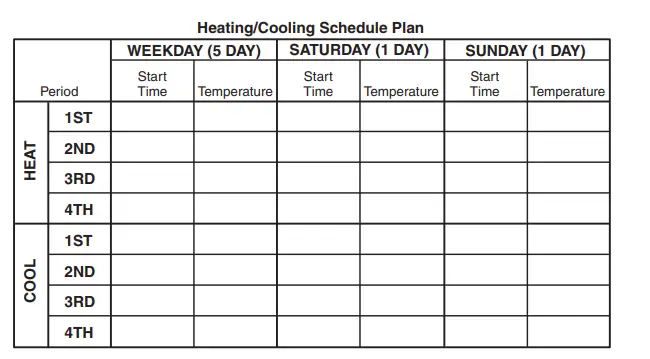
- Press and hold either
 or
or  until you reach the correct hour and AM/PM designation (AM begins at midnight; AM PM begins at noon).
until you reach the correct hour and AM/PM designation (AM begins at midnight; AM PM begins at noon). - Press TIME once. The display window will show the minutes only.
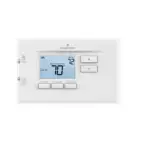
- Press and hold either
 or
or  until you reach the correct minutes.
until you reach the correct minutes. - Press
 or
or  until you reach the current day of the week
until you reach the current day of the week - Press RUN once. The display will show the correct time and room temperature alternately.

Enter Heating Program
- . Move the SYSTEM switch to HEAT.
- Press PRGM once. “MO TU WE TH FR” (indicating week- MO TU WE TH FR day program) will appear on the display. Also displayed are the currently programmed start time for the 1st heating period and the currently programmed temperature (flashing).

This display window shows that for the 1st weekday period, the start time is 6:00 AM, and 68° is the programmed temperature (this example reflects factory preprogramming). - Press
 or
or  to change the displayed temperature to your selected temperature for the 1st heating program period.
to change the displayed temperature to your selected temperature for the 1st heating program period. - Press TIME once (the programmed time will flash). Press
 or
or  until your selected time appears. The time will change in 15-minute increments. When your selected time is displayed, press TIME again to return to the change temperature mode.
until your selected time appears. The time will change in 15-minute increments. When your selected time is displayed, press TIME again to return to the change temperature mode. - Press PRGM once. The currently programmed start time and setpoint temperature for the 2nd heating 2nd heating program period will appear.
- Repeat steps 3 and 4 to select the start time and heating temperature for the 2nd heating program period.
- Repeat steps 3 through 5 for the 3rd and 4th heating program periods. Weekday heating programs are now complete.
- Press PRGM once. “SA” (indicating Saturday program) will SA appear in the display, along with the start time for the 1st heating period and the currently programmed temperature.
- Repeat steps 3 through 7 to complete Saturday heating programming.
- Press PRGM once. “SU” (indicating Sunday program) will SU appear in the display, along with the start time for the 1st heating period and the currently programmed temperature.
- Repeat steps 3 through 7 to complete Sunday heating programming.
- When you have completed entering your heating program, press RUN.

Enter Cooling Program
CAUTION
If the outside temperature is below 50°F, disconnect If the outside temperature is below 50°F, disconnect power to the cooling system before programming. power to the cooling system before programming. Energizing the air conditioner compressor during cold weather may cause personal injury or property damage. the weather may cause personal injury or property damage.
- Move SYSTEM switch to COOLposition.
- Follow the procedure for entering your cooling program, using your selected cooling times and temperatures.
CHECK YOUR PROGRAMMING
Follow these steps to check your thermostat programming one final time before beginning thermostat operation.
- Move SYSTEM switch to HEATposition.
- Press PRGM to view the 1st weekday heating period time and temperature. Each time you press PRGM, the next heating period time and temperature will be displayed in sequence for weekday, then weekend program periods (you may change any time or temperature during this procedure).
- Press RUN.
- Move SYSTEM switch to COOLposition.
- Repeat step 2 to check the cooling program.
- Move SYSTEM switch to HEAT or HEAT COOLand press RUN to begin program operation.
YOUR THERMOSTAT IS NOW COMPLETELY PROGRAMMED AND READY TO PROVIDE MAXIMUM COMFORT AND EFFICIENCY!
TROUBLESHOOTING
Reset Operation
If a voltage spike or static discharge blanks out the display or causes erratic thermostat operation you can reset the thermo stat by pressing  ,
,  and TIME at the same time. This also resets the factory defaults to the configuration menu and program. If the thermostat has power, has been reset and still does not function correctly contact your heating/cooling service person or place of purchase.
and TIME at the same time. This also resets the factory defaults to the configuration menu and program. If the thermostat has power, has been reset and still does not function correctly contact your heating/cooling service person or place of purchase.
Batteries
For optimum performance, we recommend replacing batteries once a year with fresh “AA” alkaline batteries.


Frequently Asked Questions
How to install it?
It’s very simple, I’m a woman who knew nothing about thermostats and I installed them myself. When you take the old thermostat off just label the wires( I believe the labels were in the new thermostat) then disconnect the wires and install them on the new one. Everything is clearly labeled on the thermostat. It took me about 15 minutes to do it by myself.
Does it have to be connected to program it or can you program it off the wall?
It has a battery backup so it can be programmed off of the wall.
I currently have a model 1F86-344 non programmable thermostat. Can I just replace that model with this programmable thermostat?
My understanding is yes. Have used both at my house. Love my programmable – makes it so much easier.
Do you leave the jumper in place for a 2-wire heat-only installation?
You can remove the jumper and put it in the empty thermostat shipping box. That’s for an air conditioning application. Attach your red wire to the RH and your white wire to the W. It’s a good thermostat. You’ll like it. “Remember to turn the power switch off at the furnace or shut the breaker off at the breaker box before working on your thermostat”
How long will the batteries last?
They last a long time. You could probably get away with changing them yearly. You could be more proactive and change them the same time that you change your smoke and carbon monoxide detector batteries when you change your clocks every 6 months for daylight savings time.
Why do time and room temperature flash?
There is not enough room on the digital display screen to keep both temp and time displayed.
Can I remove this unit from the mount so I can set it ion a table to program it?
As long as the batteries remain in the unit, I believe you can. You’d need to unscrew it from the wall, disconnect the wires, etc. So it’s really not worth it, as it is pretty easy to program to begin with.
Does it make a loud click or a light click or no click at all when it turns on/off?
It makes a light click when turning on or off. it runs on 2 AA batteries so its likely a pretty small relay in there.
The unit occasionally shuts down, and won’t restart. Does anyone know why, and how to remedy this? We’re wondering if it shuts down with power and loss.
I have two of them. I m thinking batteries. If replacing batteries didn’t solve then it might be on the furnace side. Or you have a defective unit. My opinion only.
I need a thermostat lock on the unit. Can anyone recommend one?
The Honeywell Thermostat Guard will cover the unit and offer protection from tampering.
Will this place the White-Rogers 1F80-51 thermostat?
I use this thermostat for heat only, if you have a 3 wire system it should work OK
Does this still need to be wired?
Yes it needs to be wired. But if you are placing an existing thermostat the existing wires should correspond nicely to the new connector block on the new thermostat. Take pictures of the existing setup before you break out the screwdriver! It helps.
Will this work for a propane gas furnace?
Propane or natural gas, the fuel shouldn’t make any difference. The only difference in the heating unit are the jets in the fuel feed. I live in the country, and my fuel is propane also. This is the thermostat that was installed by the original contractor, and what I have used as a replacement.
Can you replace 1f80-224 with this 1f80-361 (my understanding is that wiring should be fine and 361 ads a heating pump)? The family prefers the looks of 361
I don’t know if the 361 supports a heat pump option. I do not have a heat pump. Only AC and gas heat. I needed to replace my old non-heat pump thermostat when died. This was just a newer model of my existing dead one. The instructions have options for many different setups.
Can the thermostat be connected to an oil heating system? Does the thermostat ship with a mounting plate to connect to the wall?
It does come with a mounting plate. I’m not sure about oil vs gas. However, it’s job is to sense temperature and turn on or off an electric signal.
Will this thermostat work with a furnace that has zoned heating?
Don’t know. Try reading the online instruction manual. Do a Google search “zone heating and the model number’
Is this a smart thermostat?
It is not a smart thermostat in the vein of a Nest or similar, e.g., no WiFi or Internet access, but it is programmable for 5 days during the week as well as Saturday and Sunday separately. Because I work from home, I have not messed with the programming aspects of it, so I cannot speak to how easy or complicated it is to set up. For what it is I am very happy with the product.